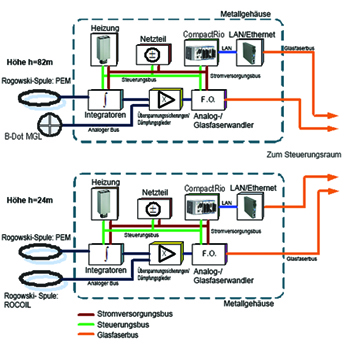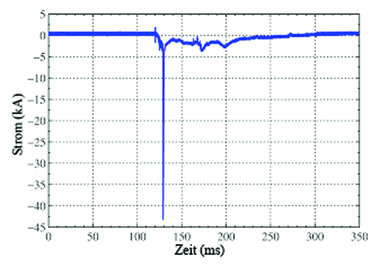Farhad Rachidi, Swiss Federal Institute of Technology (EPFL), Lausanne, Switzerland
Marcos Rubinstein University of Applied Sciences of Western Switzerland (HEIG-VD), Yverdon-Les-Bains, Switzerland
The problem of lightning electromagnetic disturbances has been undergoing thorough reconsideration for the past few years due to the increasing complexity of electrical power and telecommunication networks and the use of increasingly sensitive electronic equipment [1]. Indeed, lightning is the largest cause of transients, faults, and outages in electric power transmission and distribution networks, and the major cause of electromagnetic interference that can affect all electronic and telecommunications systems (e.g. [2]).
Our current knowledge of lightning current parameters comes essentially from direct measurements obtained using instrumented towers [3]. Extensive experimental data recorded by Prof. Berger’s team on the top of two instrumented towers in Monte San Salvatore (TI) during the 1970s resulted in a complete statistical characterization of lightning current parameters [4]. However, the results obtained by Prof. Berger and his team suffered from the technological limitations of the instruments available at the time, in particular an insufficient frequency bandwidth of a few hundred kHz, insufficient to record the spectrum of lightning currents, which exhibits significant energy content for frequencies up to a few MHz [5]. Recent experimental observations on tall telecommunication towers as well as theoretical analyses suggest, in addition, that the lightning current data obtained by means of instrumented towers might be affected by the presence of the tower itself [3, 6]. As a consequence, the adequacy of the present statistical lightning current data, which are used extensively by researchers and engineers today, has become questionable and there is an pressing need to obtain high-quality, directly-measured lightning data.
To address this need, we have setup a new experimental station for the measurement of lightning currents on the Säntis Tower (see Figure 1). This tower is a unique structure to collect experimental information related to the lightning discharge. A multiyear analysis on the lightning incidence to several towers in various places in Switzerland resulted in the choice of the Säntis tower, which is struck by lightning about 100 times a year.
Figure 1. Säntis Tower.
The new station has been instrumented using advanced and modern equipment including remote monitoring and control capabilities for an accurate measurement of lightning current parameters [7].
Measurement System
The lightning current is measured at two different heights, 24 m and 82 m.
At the lower height, we installed two Rogowski coils with different sensitivities, each one with its analog integrator used to obtain the current waveform. These Rogowski sensors were manufactured, respectively, by PEM Inc. and ROCOIL.
Two sensors were installed at 82 m. The first one is a Rogowski coil (PEM Inc.) with its analog integrator. The second sensor used at that height is a specially-designed magnetic loop (B-Dot) sensor, specifically developed to measure the lightning current derivative [8].
A schematic diagram of the current measurement system is shown in Figure 2. The analog outputs of the sensors are relayed to a digitizing system by means of A/D – D/A 12-bit optical links characterized by an overall bandwidth of DC to 25 MHz.
Figure 2. Diagram of the current measurement system on the Säntis Tower. (Adapted from [9]).
The status and settings of each pair of sensors can be monitored and changed by means of a control system designed and built using National Instruments Compact-RIO modules linked via fiber optics using 100Base-FX Ethernet. Such a system allows an over-the-Internet remote maintenance, monitoring and control of the overall measurement chain.
A control room several tens of meters from the base of the tower houses a local server running monitoring and storage tasks and a front-end station connected to the internet over a router and a standard ADSL link. More details on the installed measurement system can be found in [8, 9].
Example of a measured current waveform associated with a positive lightning flash
Even though positive lightning flashes are less frequent than negative ones, they are of particular interest for a number of reasons, most importantly because they are characterized by high peak currents and large impulse charges [10]. As a result, they are a major concern for the designers of lightning protection systems of structures such as wind turbines and telecominucation towers. The phenomenon is still not well understood but it is believed that positive lightning is associated with positive charge pockets in the upper parts of thunderclouds and they appear to be associated with lightning discharges occuring above the clouds in the middle atmosphere [11].
Furthermore, experimental data on positive lightning are very limited and often controversial [10]. A better understanding of positive lightning is therefore needed for studying cloud electrification mechanisms, charge distribution in thunderclouds, lightning discharges in the middle and upper atmosphere and improved lightning protection of systems [10].
About 20% of the recorded flashes on the Säntis Tower in 2010 were of positive polarity, all of them being recorded during the summer time [12]. This percentage is considerably larger than the values observed in other studies in summer months, which ranges from 3% to 6.5% [10]. All the observed flashes were apparently of upward type (they were initiated by upward leaders from the tower).
Figure 3 shows the plot of the current associated with a positive flash. The current is characterized by an initial, slowly rising portion lasting a few milliseconds followed by the main pulse and a long continuing current [12]. The peak of the current is 43 kA and the total duration is about 150 ms. The total charge transferred to ground is about 290 C.
Figure 3. Current waveform associated with a positive flash recorded on July 21, 2010, 19:05.
It is foreseen that the site will be operational beyond the framework of this project and will be operated by the EPFL and the HEIG-VD and other international partners to obtain data on lightning.
The project was supported by the State Secretariat for Education and Research, the Swiss National Science Foundation and the European COST Action P18.
References
[1] V. Cooray, Lightning Protection: IET, 2010.
[2] C. A. Nucci and F. Rachidi, “Interaction of electromagnetic fields generated by lightning with overhead electrical networks,” in The Lightning Flash, ed: IEE, 2003, pp. 425-478.
[3] V. A. Rakov and F. Rachidi, “Overview of Recent Progress in Lightning Research and Lightning Protection,” IEEE Transactions on Electromagnetic Compatibility, vol. 51, pp. 428-442, 2009.
[4] K. Berger, R. B. Anderson, and H. Kroninger, “Parameters of lightning flashes,” Electra. no., vol. 41, pp. 23-37, 1975.
[5] V. A. Rakov and M. A. Uman, Lightning: physics and effects: Cambridge University Press, 2003.
[6] F. Rachidi, “Modeling Lightning Return Strokes to Tall Structures: A Review,” Journal of Lightning Research, vol. 1, pp. 16-31, January 2007.
[7] C. Romero, A. Rubinstein, M. Paolone, F. Rachidi, M. Rubinstein, P. Zweiacker, and B. Daout, “Instrumentation of the Säntis Tower in Switzerland for lightning current measurements,” International Journal of Plasma Environmental Science & Technology, vol. 4, pp. 79-85, 2010.
[8] C. Romero, A. Mediano, A. Rubinstein, F. Rachidi, M. Rubinstein, M. Paolone, N. Mora, D. Pavanello, P. Zweiacker, and B. Daout, “Measurement of lightning currents using a combination of Rogowski coils and B-Dot sensors,” in 30th International Conference on Lightning Protection (ICLP), Cagliari, Italy, 2010.
[9] C. Romero, M. Paolone, M. Rubinstein, F. Rachidi, A. Rubinstein, G. Diendorfer, W. Schulz, B. Daout, A. Kaelin, and P. Zweiacker, “A System for the Measurements of Lightning Currents at the Säntis Tower,” Electric Power System Research Journal, submitted, 2011.
[10] V. A. Rakov, “A Review of Positive and Bipolar Lightning Discharge,” Bull. Am. Meteor. Soc., vol. 84, pp. 767-776, 2003.
[11] S. A. Yashunin, E. A. Mareev, and V. A. Rakov, “Are lightning M components capable of initiating sprites and sprite halos?,” J. Geophys. Res., vol. 112, p. D10109, 2007.
[12] C. Romero, M. Paolone, F. Rachidi, M. Rubinstein, A. Rubinstein, P. Zweiacker, and C. A. Nucci, “Current Waveforms Associated with Positive Flashes Recorded on the Säntis Tower in Summer 2010 “ in XI International Symposium on Lightning Protection (SIPDA), Fortaleza, Brazil, 2011.
Farhad Rachidi is the head of the Electromagnetic Compatibility (EMC) Group of of the Swiss Federal Institute of Technology (EPFL). Rachidi (IEEE Fellow, EMP Fellow, Electromagnetics Academy Fellow) was born in Geneva in 1962. He received the M.S. degree in electrical engineering and the Ph.D. degree from the Swiss Federal Institute of Technology, Lausanne, in 1986 and 1991 respectively. He worked at the Power Systems Laboratory of the same institute until 1996 and had several short stays at the University of Florida and the NASA Kennedy Space Center. In 1997, he joined the Lightning Research Laboratory of the University of Toronto in Canada and from April 1998 until September 1999, he was with Montena EMC in Switzerland. His research interests concern electromagnetic compatibility, lightning electromagnetics and electromagnetic field interactions with transmission lines.
Marcos Rubinstein received the Bachelor’s degree in electronics from Simon Bolivar University, Caracas, Venezuela in 1982, and the Master’s and Ph.D. degrees in electrical engineering from the University of Florida, Gainesville in 1986 and 1991. In 1992 he joined the Swiss Federal Institute of Technology in Lausanne, where he was active in the fields of electromagnetic compatibility and lightning in close cooperation with the former Swiss PTT (Post, Telegram, Telegraph). In 1995, he took a position at Swisscom, where he was involved in numerical electromagnetics and EMC in telecommunications and where he led a number of coordinated projects covering the fields of EMC and biological effects of electromagnetic radiation. In 2001, he moved to the University of Applied Sciences of Western Switzerland, Yverdon-les-bains (HEIG-VD), where he is currently a professor in telecommunications and a member of the Institute for Information and Communication Technologies (IICT) team.







